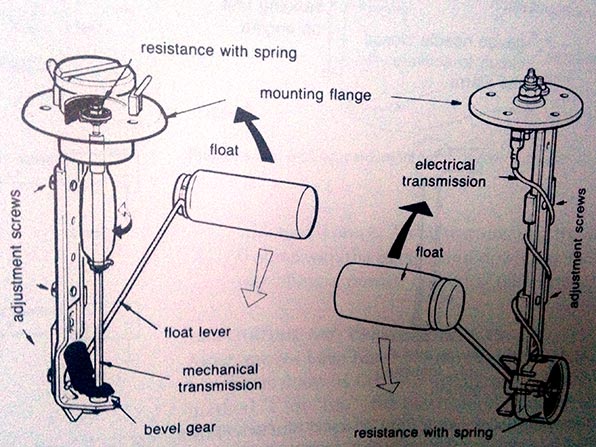Something new to play with
Two days ago I wrote how I seldom consult my reference books for info on our boat systems. Yesterday, I decided to give them another chance.

Nigel Calder’s book Marine Diesel Engines includes the above illustration of a fuel tank float sensor. After reading what he had to say about the devices, and chatting with our friend Wiley, I decided to try to remove ours from the tank to see if there were any obvious problems with it. Unfortunately, after a slightly tricky time of getting it out of the small hole, I found no obvious issues. In fact, the float appears fine, the arm appears to move freely and the resistance when checked on my ohm meter varies as the arm is moved. That was as far as I got with it yesterday. Today I’m going to check the gauge itself and if necessary, swap the sensor into the starboard tank to see if it gives the same false readings.




Remember to check your connections (clean and tight). Corrosion in the wires at the terminals can cause erroneous readings.
The visible connections of all the wires are in good shape.
Pretty cool that Calder’s illustration is the exact same sensor as the one you have in your tanks. I have read his book cover to cover and will keep it aboard always. Good stuff in there and reading it makes you feel a little less vulnerable and dependant on others at sea!
I just can’t READ books like that. I don’t retain info that way. I need to DO things. I do find it helpful to read up on something before I start taking it apart though. It was that book which showed me that the float acts like a variable resistor (rheostat).
Mike – There is one more part of the system: the wire that connects the sender with the gauge.
Also, a couple of things I learned when replacing the senders on Eolian‘s tanks…
First, because the arm is moving freely when you are holding the sender in your hand does not mean that the arm is free to move when in position inside the tank. The float could be interfering with the tank wall, an internal baffle, or the fuel pickup tube.
Second, the sender is designed to work in a tank with a linear relationship between depth and volume. Most marine tanks fail this, being wedge shaped. That means that the top 1/4 of the gauge holds a *lot* more fuel than the bottom 1/4.
On our tanks, these things meant that, with the arm short enough to not interfere with the far tank wall, the float lays on the bottom slope of the tank when there is still maybe 6″ fuel remaining. We regard this “invisible” fuel as the emergency reserve.
Bob
s/v Eolian
Seattle
I understand that the arm would need to move freely. If I could feel any obstruction (baffle?), it was in the tank that is working! I swapped both senders and the trouble remained. When I jumped the helm gauges to the opposite sender, the problem remained on the port side. I am using that info to deduce that the gauge itself is faulty.
Are you going to hook the sending unit directly to the gauge with jumper wires? That would be the best test for the gauge… It could also be a fluky resistor on the sending unit– Maybe not making good conduct from the float to the resistor? I’ve seen that before…
Good Luck– Lets us know what you find…
As I mentioned in the other comment, I think it is the gauge now, not the sender. We will see.
I think you’re on the right track. Swap the sensor (electrically connect it, and move the slider up and down) and see if the sensor fails to drive either of your 2 gauges. If you’ve got easy access to the back of the gauges, try and connect the sensor right there. It could be a corroded wire between the gauge and the sensor, or a bad connection somewhere. Does the good gauge still work after getting its resident sensor back? Process of elimination…..
Corrosion? On our boat? Hah. 🙂
That the resistance changes is necessary but not sufficient. It must be a continuous change over the whole movement range, no back and forth or dropouts. 😀
Looks like a VDO sending unit, it should use low resistance (~3 Ohm) to signal an empty tank, 180 Ohm for a full tank.
If i guessed right you could have a short somewhere on the way to the gauge. In that case reconnecting the sending unit outside the tank. And observe the gauge. If that is not conclusive disconnecting the gauge and and comparing measurements at the tank and at the gauge should help. That also works if the sender actually uses high resistance to signal an empty tank and could be easier than removing the second sending unit.
Sending unit and gauge have be compatible. As always various manufactures invented their own, incompatible, systems using various resistance ranges. If the gauge worked in the past that should not be the problem but rather something to keep in mind buying a replacement.
Lastly, if it’s VDO it’s a car part and hast the same part number in their marine and car catalogs. No need to pay marine tax.
Good info. I’ll be checking Napa before Budget Marine then!
If you ground the + wire at the tank the gauge should peg, if it doesn’t the problem is in the gauge or wiring. If it does peg the gauge the problem is in the float assy.
Right.
The key switch will have to be on when you do that test to power the gauge circuit.
Does the swing arm have room to travel in the tank the way the sender was oriented when mounted? I can see the possibility that if the sender is mounted in a rectangular tank, the float might not have room to drop all the way down.
Also, does the float, float? If it’s no longer a float, then you might have another area to check.
Yes. Yes.